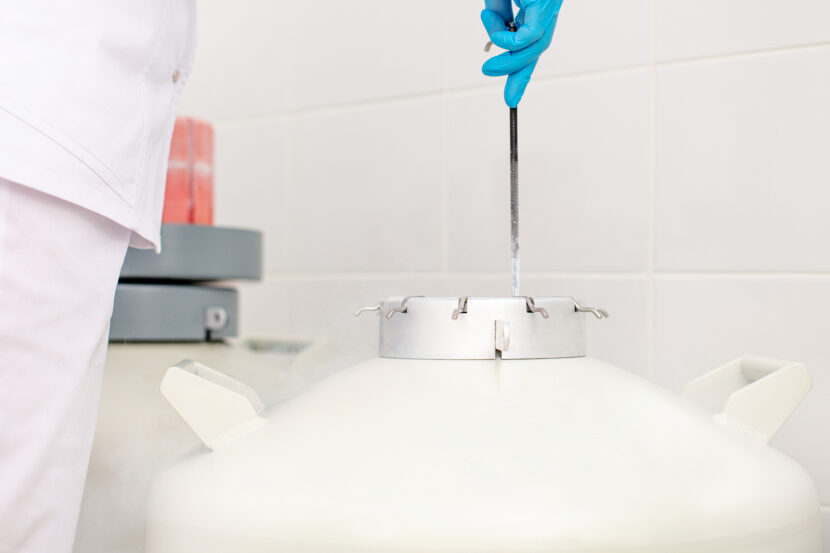The preservation of female fertility is possible through the most accepted approaches such as oocyte or embryo cryopreservation. The embryo cryopreservation, also known as embryo freezing, involves several steps of in vitro fertilization (IVF), and requires an available or willing partner’s sperm or a donor sperm for the fertilization of the eggs.
How is Embryo Freezing Performed?
Embryo cryopreservation can be performed using different techniques. The most popular technique is the rapid freezing method or Vitrification. However, there is also a slow freezing method, and most studies on the embryo cryopreservation is done on this method. Further research on new techniques is ongoing. The vitrification method is considered better than the slow-freezing method for it offers higher success rates.
Generally, embryo freezing is performed at pronuclear, cleavage and blastocyst stages. Embryo cryopreservation is done between the first and sixth day after fertilization based on the stage embryos are frozen. The embryos that usually develop are chosen for cryopreservation. For the purpose, they will be left in a number of solutions for freezing with increasing levels of cryoprotectants, which are substances used to replace the water in the embryos, and protect them from any damages on freezing. Once the embryos are frozen, they are stored in liquid nitrogen at -196° C or -371° F.
There Are Two Methods of Freezing Embryos:
- Slow Freezing: Under this method, the embryos are frozen slowly in stages in a machine by lowering the temperature. The cryoprotectants are added in increasing strengths every 10-20 minutes. The embryos take about two hours to cool in temperature that gets reduced every minute. The frozen embryos are then transferred to liquid nitrogen. The slow-freezing method is considered to be time-consuming.
- Vitrification: Under the vitrification method, the cryoprotectants in higher strengths are added to the embryos, and quickly frozen to not allow the water content in the embryos to form ice crystals. They are then placed in liquid nitrogen to use later.
The frozen embryo cells are soaked in a special fluid to remove the cryoprotectants and thawed when required. This help the cells to have the normal water balance.
What is the Success Rate of Using Frozen Embryos for Pregnancy?
When it comes to the success rates of using frozen embryos, they are found to be higher owing to a chance to optimize implantation through highly efficient endometrium. They are comparable to fresh embryo cycles with the similar principal indicator for success. Studies show that women who are 35 years and younger have a 60 percent chance of becoming pregnant with frozen embryos.
However, the success rate decreases with the increase in the maternal age of women. For instance, women at 40 have a 20 percent chance of becoming pregnant using a frozen embryo transfer (FET).
Various Benefits of Embryo Freezing
With embryo cryopreservation, couples can have several benefits, and they are those who:
Want to Delay Pregnancy
The women who want to realize their personal goal or have personal or financial commitments look for opportunities to delay pregnancy or starting a family. By opting for embryo cryopreservation, they can preserve the high-quality embryos when they are in 20s and have a baby when they would be in 30s or 40s. As the women grow older, the chances of becoming pregnant reduce because of the ovaries becoming ineffective in producing and developing mature and healthy eggs. With embryo freezing, women can plan and grow their family when they want.
Also, Read: Difference between Egg and Embryo Freezing
Undergo Cancer Treatments
Those men or women who undergo cancer treatments may have a high risk of infertility. The radiation therapy may affect the egg’s DNA and support cells. It also has an impact on the blood supply in the uterus by increasing the chances of early birth, miscarriage and low birth weight. The anti-cancer drugs such as doxorubicin, epirubicin and daunorubicin may reduce the egg and sperm cells’ viability. For these reasons, the women who have to undergo intensive cancer therapy opt for embryo cryopreservation to store their embryo before the treatment, and have a baby later.
Want to Undergo Genetic Testing
Embryo freezing can help those women who want to use their screened embryo for uterine implantation in case they are concerned about passing genetic disorders to their baby. With preimplantation genetic screening (PGS), they can know the number of chromosomes present in the embryo, and ensure the transfer of only chromosomally normal embryos.
Also, Read: Genetic Testing for Your Embryos
More Chances for Successful Pregnancy
More than one embryos can be preserved through cryopreservation, and this offers better chances of becoming pregnant. If a frozen embryo, which is transferred to the uterus, is unsuccessful in making a woman pregnant, she can have another one and the other one. This increases her chances of becoming pregnant.
In addition to above, the embryo freezing enables a woman have subsequent frozen embryo transfers at less cost because of minimal medication.
